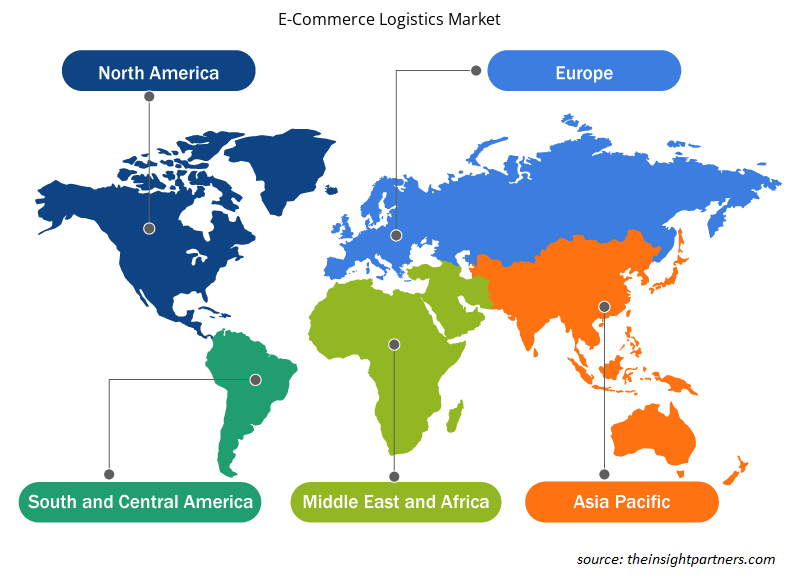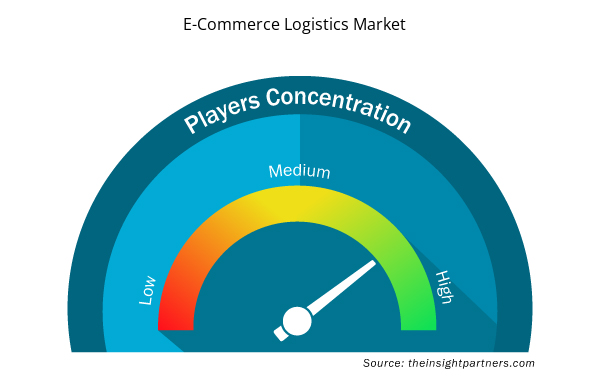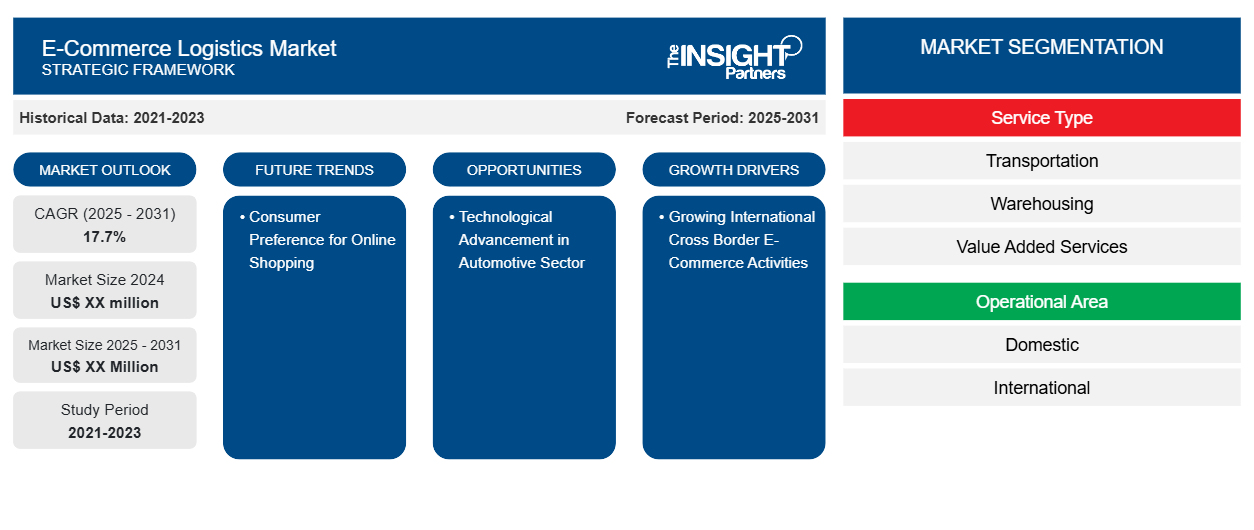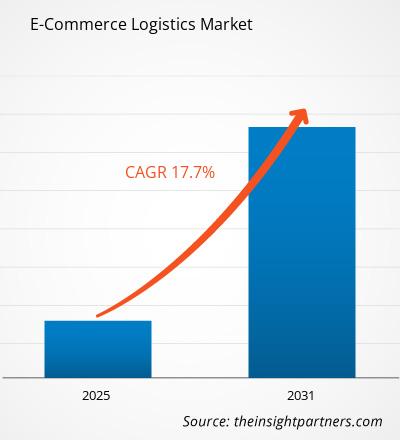Der E-Commerce-Logistikmarkt wird im Zeitraum 2023–2031 voraussichtlich eine durchschnittliche jährliche Wachstumsrate von 17,7 % verzeichnen. Die Entwicklung fortschrittlicher Technologien im Logistiksektor und die wachsende Vorliebe der Verbraucher für Online-Shopping dürften weiterhin ein wichtiger Trend auf dem Markt bleiben.
E-Commerce-Logistik-Marktanalyse
- Es wird erwartet, dass der globale E-Commerce-Logistikmarkt im Prognosezeitraum ein hohes Wachstum verzeichnen wird.
- Die zunehmenden grenzüberschreitenden Handelsaktivitäten und die wachsende Vorliebe der Verbraucher für Online-Shopping werden voraussichtlich die Nachfrage nach dem E-Commerce-Logistikmarkt auf globaler Ebene ankurbeln.
E-Commerce-Logistikmarktübersicht
- Der E-Commerce-Logistikmarkt umfasst Dienstleistungen wie Verpackung , Mehrwertdienste, Transport und Lagerhaltung.
- Das Wachstum digitaler Technologien hat zu einer erhöhten Nachfrage nach E-Commerce-Logistik in verschiedenen Anwendungsbereichen geführt.
- Die Haupttreiber des Wachstums des Online-Handels sind die Ausweitung des länderübergreifenden elektronischen Handels und die steigende Zahl der Internetnutzer, insbesondere in den Entwicklungsländern.
Passen Sie diesen Bericht Ihren Anforderungen an
Sie erhalten kostenlos individuelle Anpassungen an jedem Bericht, einschließlich Teilen dieses Berichts oder einer Analyse auf Länderebene, eines Excel-Datenpakets sowie tolle Angebote und Rabatte für Start-ups und Universitäten.
- Holen Sie sich die wichtigsten Markttrends aus diesem Bericht.Dieses KOSTENLOSE Beispiel umfasst eine Datenanalyse von Markttrends bis hin zu Schätzungen und Prognosen.
Treiber und Chancen auf dem E-Commerce-Logistikmarkt
Wachsende internationale grenzüberschreitende E-Commerce-Aktivitäten begünstigen den Markt
- Die zunehmende Verbreitung internationaler, grenzübergreifender E-Commerce-Aktivitäten dürfte das Wachstum des E-Commerce-Logistikmarktes vorantreiben.
- Urbanisierung, steigendes verfügbares Einkommen in Entwicklungsmärkten sowie technologischer Fortschritt und Leistung treiben die Entwicklung des E-Commerce-Logistikmarktes voran.
Verbraucherpräferenz für Online-Shopping
- Die zunehmende Vorliebe der Verbraucher für Online-Shopping treibt die Nachfrage im E-Commerce-Logistikmarkt weltweit an.
- Die Kunden entscheiden sich dafür, bequem von zu Hause aus einzukaufen, und nach Covid entscheiden sich die Kunden für Online-Einkaufsoptionen, da sie online mehr Auswahl haben als in physischen Geschäften, was auch dem E-Commerce-Logistikmarkt auf globaler Ebene Auftrieb verleiht.
Segmentierungsanalyse des E-Commerce-Logistikmarktberichts
Wichtige Segmente, die zur Ableitung der E-Commerce-Logistikmarktanalyse beigetragen haben, sind Servicetyp, Betriebsbereich, Kategorie und Endbenutzer.
- Basierend auf der Art der Dienstleistung ist der E-Commerce-Logistikmarkt in Transport und Lagerhaltung unterteilt.
- Basierend auf dem Einsatzgebiet wird der E-Commerce-Logistikmarkt in international und inländisch unterteilt.
- Basierend auf der Kategorie ist der E-Commerce-Logistikmarkt in Bekleidung und Lifestyle, Automobil, Bücher und Zeitschriften, FMCG und Unterhaltungselektronik , Gesundheitswesen und Sonstiges unterteilt.FMCG and consumer
- Basierend auf den Endbenutzern ist der E-Commerce-Logistikmarkt in B2B und B2C unterteilt.
E-Commerce-Logistik Marktanteilsanalyse nach Geografie
- Der Marktbericht für E-Commerce-Logistik umfasst eine detaillierte Analyse von fünf großen geografischen Regionen, die die aktuelle und historische Marktgröße sowie Prognosen für die Jahre 2021 bis 2031 umfasst und Nordamerika, Europa, den asiatisch-pazifischen Raum (APAC), den Nahen Osten und Afrika (MEA) sowie Süd- und Mittelamerika abdeckt.APAC), Middle East and Africa (MEA), and South & Central America.
- Jede Region ist weiter in entsprechende Länder unterteilt. Dieser Bericht bietet Analysen und Prognosen für mehr als 18 Länder und deckt die Dynamik des E-Commerce-Logistikmarkts ab, wie etwa Treiber, Trends und Chancen, die die Märkte auf regionaler Ebene beeinflussen.
- Darüber hinaus umfasst der Bericht eine PEST-Analyse, in deren Rahmen die wichtigsten Faktoren untersucht werden, die den E-Commerce-Logistikmarkt in diesen Regionen beeinflussen.
Regionale Einblicke in den E-Commerce-Logistikmarkt
Die regionalen Trends und Faktoren, die den E-Commerce-Logistikmarkt im Prognosezeitraum beeinflussen, wurden von den Analysten von Insight Partners ausführlich erläutert. In diesem Abschnitt werden auch die Marktsegmente und die Geografie des E-Commerce-Logistikmarkts in Nordamerika, Europa, im asiatisch-pazifischen Raum, im Nahen Osten und Afrika sowie in Süd- und Mittelamerika erörtert.

- Erhalten Sie regionale Daten zum E-Commerce-Logistikmarkt
Umfang des E-Commerce-Logistikmarktberichts
| Berichtsattribut | Details |
|---|---|
| Marktgröße im Jahr 2023 | XX Millionen US-Dollar |
| Marktgröße bis 2031 | XX Millionen US-Dollar |
| Globale CAGR (2024 - 2031) | 17,7 % |
| Historische Daten | 2021-2022 |
| Prognosezeitraum | 2024–2031 |
| Abgedeckte Segmente | Nach Servicetyp
|
| Abgedeckte Regionen und Länder | Nordamerika
|
| Marktführer und wichtige Unternehmensprofile |
|
Marktteilnehmerdichte: Der Einfluss auf die Geschäftsdynamik
Der Markt für E-Commerce-Logistik wächst rasant, angetrieben durch die steigende Nachfrage der Endnutzer aufgrund von Faktoren wie sich entwickelnden Verbraucherpräferenzen, technologischen Fortschritten und einem größeren Bewusstsein für die Vorteile des Produkts. Mit steigender Nachfrage erweitern Unternehmen ihr Angebot, entwickeln Innovationen, um die Bedürfnisse der Verbraucher zu erfüllen, und nutzen neue Trends, was das Marktwachstum weiter ankurbelt.
Die Marktteilnehmerdichte bezieht sich auf die Verteilung von Firmen oder Unternehmen, die in einem bestimmten Markt oder einer bestimmten Branche tätig sind. Sie gibt an, wie viele Wettbewerber (Marktteilnehmer) in einem bestimmten Marktraum im Verhältnis zu seiner Größe oder seinem gesamten Marktwert präsent sind.
Die wichtigsten auf dem E-Commerce-Logistikmarkt tätigen Unternehmen sind:
- Clipper Logistics Plc.
- Ceva Holdings LLC
- Aramex International
- Amazonas
- United Parcel Service, Inc.
- FedEx Corporation
Haftungsausschluss : Die oben aufgeführten Unternehmen sind nicht in einer bestimmten Reihenfolge aufgeführt.

- Überblick über die wichtigsten Akteure auf dem E-Commerce-Logistikmarkt
Neuigkeiten und aktuelle Entwicklungen zum E-Commerce-Logistikmarkt
Der E-Commerce-Logistikmarkt wird durch die Erhebung qualitativer und quantitativer Daten nach Primär- und Sekundärforschung bewertet, die wichtige Unternehmenspublikationen, Verbandsdaten und Datenbanken umfasst. Nachfolgend sind einige der Entwicklungen auf dem E-Commerce-Logistikmarkt aufgeführt:
- DHL Global Forwarding hat sich mit Schneider Electric zusammengetan, um ein branchenweit erstes multimodales Versandmodell zu entwickeln und einzuführen, das nachhaltige Flugkraftstoffe (SAFs) verwendet, um die Agilität zu verbessern und die Umweltauswirkungen seiner Lieferkette zu reduzieren. Gemeinsam mit Schneider Electric hat DHL Global Forwarding zwei multimodale Versandbrücken eingerichtet – zwischen Singapur und Nordamerika sowie zwischen Indien und Nordamerika – um die CO2-Emissionen der Kategorie 3 aus der Luftfracht zu reduzieren. Insgesamt plant Schneider Electric, mit seinen Logistikpartnern acht globale multimodale Brücken zu entwerfen und zu bauen, die bei Bedarf eingesetzt werden können. (Quelle: DHL Global Forwarding, Pressemitteilung, Februar 2024)
- DHL Global Forwarding, der führende internationale Anbieter von Luft-, See- und Straßenfrachtdienstleistungen, hat in Johannesburg, Südafrika, ein neues Umschlagzentrum und eine neue Hauptniederlassung eröffnet. (Quelle: DHL Global Forwarding, Pressemitteilung, September 2022)
Marktbericht zur E-Commerce-Logistik – Umfang und Ergebnisse
Der Bericht „Marktgröße und Prognose für E-Commerce-Logistik (2021–2031)“ bietet eine detaillierte Analyse des Marktes, die die folgenden Bereiche abdeckt:
- Größe und Prognose des E-Commerce-Logistikmarktes auf globaler, regionaler und Länderebene für alle wichtigen Marktsegmente, die im Rahmen des Projekts abgedeckt sind
- Markttrends und Marktdynamiken im Bereich E-Commerce-Logistik wie Treiber, Einschränkungen und wichtige Chancen
- Detaillierte PEST/Porters Five Forces- und SWOT-Analyse
- Analyse des E-Commerce-Logistikmarkts mit Blick auf wichtige Markttrends, globale und regionale Rahmenbedingungen, wichtige Akteure, Vorschriften und aktuelle Marktentwicklungen.
- Branchenlandschaft und Wettbewerbsanalyse, einschließlich Marktkonzentration, Heatmap-Analyse, prominenten Akteuren und aktuellen Entwicklungen auf dem E-Commerce-Logistikmarkt
- Detaillierte Firmenprofile
- Historische Analyse (2 Jahre), Basisjahr, Prognose (7 Jahre) mit CAGR
- PEST- und SWOT-Analyse
- Marktgröße Wert/Volumen – Global, Regional, Land
- Branche und Wettbewerbsumfeld
- Excel-Datensatz


- Trade Promotion Management Software Market
- Joint Pain Injection Market
- Cosmetic Bioactive Ingredients Market
- Pipe Relining Market
- Rugged Servers Market
- Photo Editing Software Market
- Volumetric Video Market
- Advanced Planning and Scheduling Software Market
- Semiconductor Metrology and Inspection Market
- Maritime Analytics Market

Report Coverage
Revenue forecast, Company Analysis, Industry landscape, Growth factors, and Trends

Segment Covered
This text is related
to segments covered.

Regional Scope
North America, Europe, Asia Pacific, Middle East & Africa, South & Central America

Country Scope
This text is related
to country scope.
Häufig gestellte Fragen
Some of the customization options available based on the request are an additional 3–5 company profiles and country-specific analysis of 3–5 countries of your choice. Customizations are to be requested/discussed before making final order confirmation, as our team would review the same and check the feasibility.
The major factors driving the E-Commerce Logistics Market are: Advent of Advanced Technology such as Automation, Blockchain, and other
The E-Commerce Logistics Market is estimated to witness a CAGR of 17.4% from 2023 to 2031
Changing customer preference is the key future trend of the E-Commerce Logistics Market
The leading players operating in the E-Commerce Logistics Market include FedEx Corporation, DHL International GmbH, Aramex International, XPO Logistics Plc.,United Parcel Service, Inc., Gati Limited, Kenco Group, Inc., Clipper Logistics Plc., Agility Public Warehousing Company K.S.C.P. and CEVA Logistics.
The report can be delivered in PDF/PPT format; we can also share excel dataset based on the request.
Trends and growth analysis reports related to Automotive and Transportation : READ MORE..
The List of Companies
1. Amazon.com, Inc.
2. C.H. Robinson Worldwide, Inc.
3. CEVA Logistics
4. Clipper Logistics Plc.
5. DHL International GmbH
6. FedEx Corporation
7. Kerry Logistics Network Limited.
8. Nippon Express Co., Ltd.
9. SF Express Co., Ltd.
10. United Parcel Service, Inc.
The Insight Partners performs research in 4 major stages: Data Collection & Secondary Research, Primary Research, Data Analysis and Data Triangulation & Final Review.
- Data Collection and Secondary Research:
As a market research and consulting firm operating from a decade, we have published and advised several client across the globe. First step for any study will start with an assessment of currently available data and insights from existing reports. Further, historical and current market information is collected from Investor Presentations, Annual Reports, SEC Filings, etc., and other information related to company’s performance and market positioning are gathered from Paid Databases (Factiva, Hoovers, and Reuters) and various other publications available in public domain.
Several associations trade associates, technical forums, institutes, societies and organization are accessed to gain technical as well as market related insights through their publications such as research papers, blogs and press releases related to the studies are referred to get cues about the market. Further, white papers, journals, magazines, and other news articles published in last 3 years are scrutinized and analyzed to understand the current market trends.
- Primary Research:
The primarily interview analysis comprise of data obtained from industry participants interview and answers to survey questions gathered by in-house primary team.
For primary research, interviews are conducted with industry experts/CEOs/Marketing Managers/VPs/Subject Matter Experts from both demand and supply side to get a 360-degree view of the market. The primary team conducts several interviews based on the complexity of the markets to understand the various market trends and dynamics which makes research more credible and precise.
A typical research interview fulfils the following functions:
- Provides first-hand information on the market size, market trends, growth trends, competitive landscape, and outlook
- Validates and strengthens in-house secondary research findings
- Develops the analysis team’s expertise and market understanding
Primary research involves email interactions and telephone interviews for each market, category, segment, and sub-segment across geographies. The participants who typically take part in such a process include, but are not limited to:
- Industry participants: VPs, business development managers, market intelligence managers and national sales managers
- Outside experts: Valuation experts, research analysts and key opinion leaders specializing in the electronics and semiconductor industry.
Below is the breakup of our primary respondents by company, designation, and region:

Once we receive the confirmation from primary research sources or primary respondents, we finalize the base year market estimation and forecast the data as per the macroeconomic and microeconomic factors assessed during data collection.
- Data Analysis:
Once data is validated through both secondary as well as primary respondents, we finalize the market estimations by hypothesis formulation and factor analysis at regional and country level.
- Macro-Economic Factor Analysis:
We analyse macroeconomic indicators such the gross domestic product (GDP), increase in the demand for goods and services across industries, technological advancement, regional economic growth, governmental policies, the influence of COVID-19, PEST analysis, and other aspects. This analysis aids in setting benchmarks for various nations/regions and approximating market splits. Additionally, the general trend of the aforementioned components aid in determining the market's development possibilities.
- Country Level Data:
Various factors that are especially aligned to the country are taken into account to determine the market size for a certain area and country, including the presence of vendors, such as headquarters and offices, the country's GDP, demand patterns, and industry growth. To comprehend the market dynamics for the nation, a number of growth variables, inhibitors, application areas, and current market trends are researched. The aforementioned elements aid in determining the country's overall market's growth potential.
- Company Profile:
The “Table of Contents” is formulated by listing and analyzing more than 25 - 30 companies operating in the market ecosystem across geographies. However, we profile only 10 companies as a standard practice in our syndicate reports. These 10 companies comprise leading, emerging, and regional players. Nonetheless, our analysis is not restricted to the 10 listed companies, we also analyze other companies present in the market to develop a holistic view and understand the prevailing trends. The “Company Profiles” section in the report covers key facts, business description, products & services, financial information, SWOT analysis, and key developments. The financial information presented is extracted from the annual reports and official documents of the publicly listed companies. Upon collecting the information for the sections of respective companies, we verify them via various primary sources and then compile the data in respective company profiles. The company level information helps us in deriving the base number as well as in forecasting the market size.
- Developing Base Number:
Aggregation of sales statistics (2020-2022) and macro-economic factor, and other secondary and primary research insights are utilized to arrive at base number and related market shares for 2022. The data gaps are identified in this step and relevant market data is analyzed, collected from paid primary interviews or databases. On finalizing the base year market size, forecasts are developed on the basis of macro-economic, industry and market growth factors and company level analysis.
- Data Triangulation and Final Review:
The market findings and base year market size calculations are validated from supply as well as demand side. Demand side validations are based on macro-economic factor analysis and benchmarks for respective regions and countries. In case of supply side validations, revenues of major companies are estimated (in case not available) based on industry benchmark, approximate number of employees, product portfolio, and primary interviews revenues are gathered. Further revenue from target product/service segment is assessed to avoid overshooting of market statistics. In case of heavy deviations between supply and demand side values, all thes steps are repeated to achieve synchronization.
We follow an iterative model, wherein we share our research findings with Subject Matter Experts (SME’s) and Key Opinion Leaders (KOLs) until consensus view of the market is not formulated – this model negates any drastic deviation in the opinions of experts. Only validated and universally acceptable research findings are quoted in our reports.
We have important check points that we use to validate our research findings – which we call – data triangulation, where we validate the information, we generate from secondary sources with primary interviews and then we re-validate with our internal data bases and Subject matter experts. This comprehensive model enables us to deliver high quality, reliable data in shortest possible time.


 Holen Sie sich ein kostenloses Muster für diesen Bericht
Holen Sie sich ein kostenloses Muster für diesen Bericht